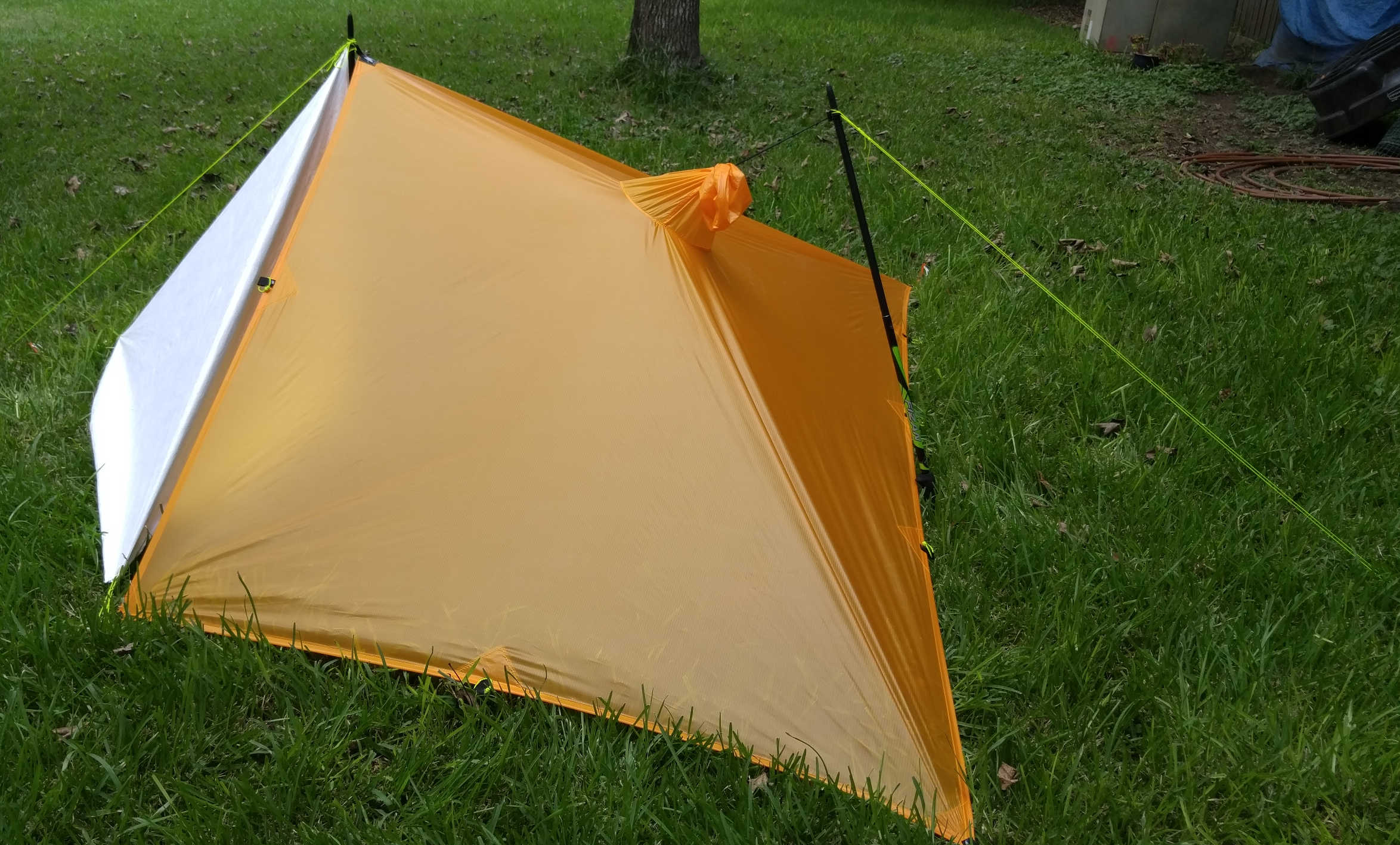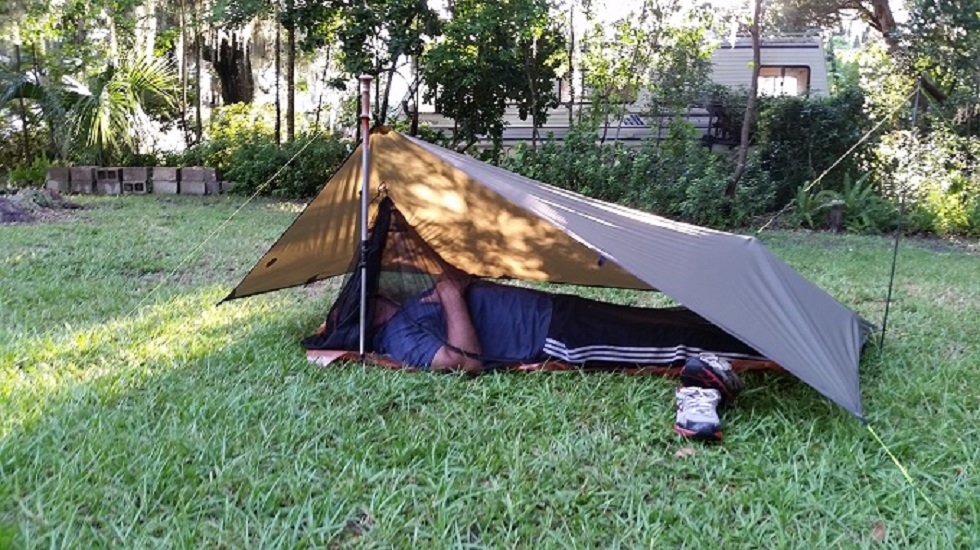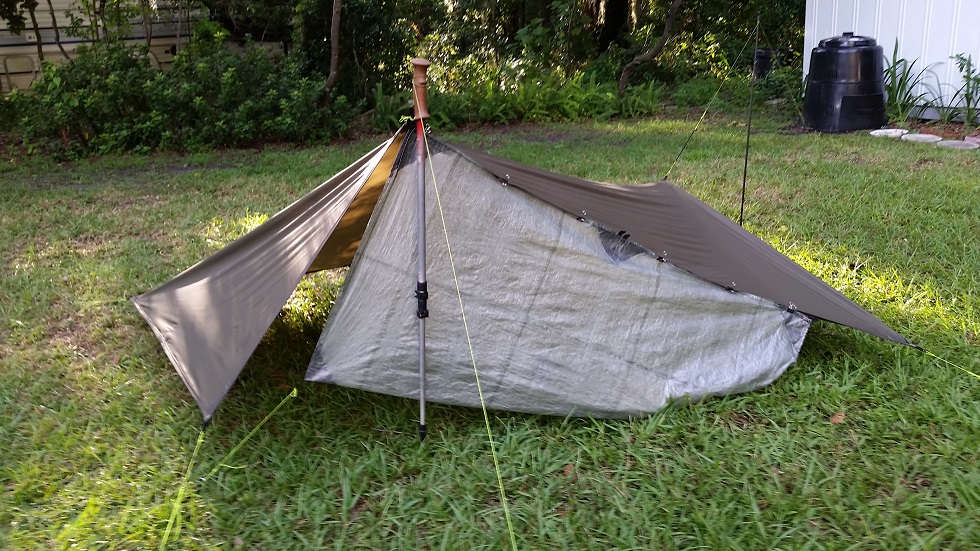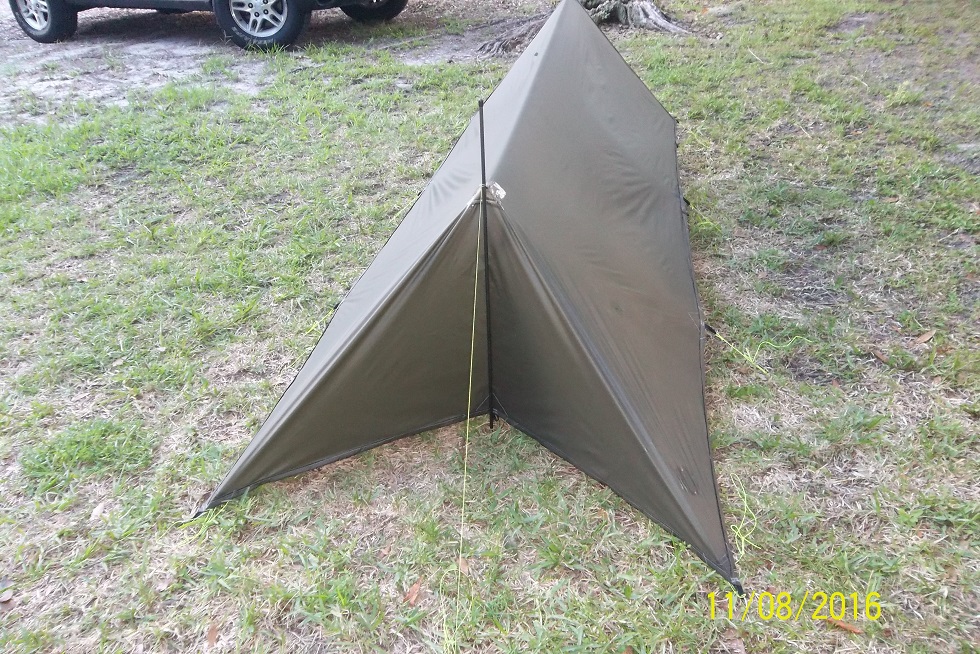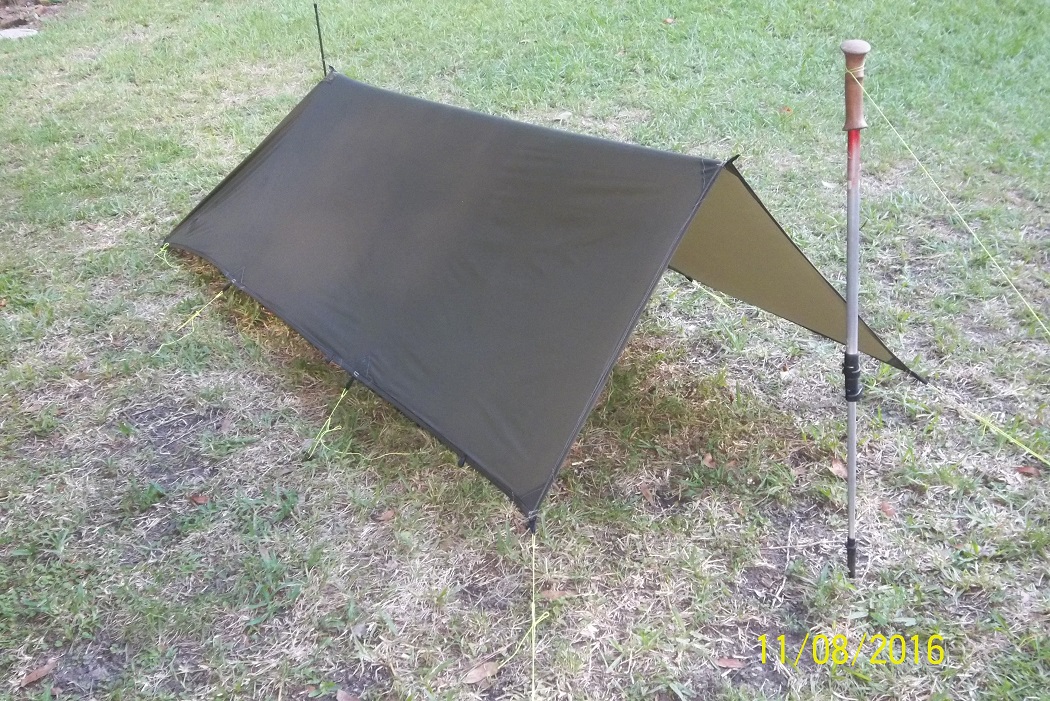Topic
Wanted: Tips & Tricks for Poncho Tarp-ing
Forum Posting
A Membership is required to post in the forums. Login or become a member to post in the member forums!
Home › Forums › General Forums › Philosophy & Technique › Wanted: Tips & Tricks for Poncho Tarp-ing
- This topic has 19 replies, 10 voices, and was last updated 7 years, 10 months ago by
 Tim Skidmore.
Tim Skidmore.
-
AuthorPosts
-
Sep 6, 2016 at 5:07 pm #3424716
I’m thinking of using a poncho tarp (MLD silnylon) for my shelter on short trips (1-3 nights) in wooded areas. I’m hoping to get answers to a few questions and some useful tips or tricks from those experienced with this. I plan on using an MLD superlight bivy for ground, bug, and splash protection. I plan on starting out with a half pyramid pitch with 3 sides staked to the ground.
- If I get condensation inside the tarp, and then I happen to rub the bivy up against it will the DWR fail and allow all that moisture to easily seep into the bivy?
- Wind permitting is it likely to reduce condensation inside the tarp if I pitch it with the bottom edge up a bit? If so, how far? If nothing else this would reduce the amount of contact between the bivy and the tarp.
- Suppose it starts raining in the middle of the night. It was a tight fit inside the tarp to begin with and now the tarp begins to sag. Am I likely to be successful in tightening up the tarp simply by raising the pole which I can reach from the bivy, or am I going to need to go out in the rain and adjust stakes?
- Has anyone had any luck using bungee cord between the tarp and stake to keep the pitch tight even after the nylon gets wet? If so, what diameter and how long? Or am I STILL going to need to go out in the rain and adjust stakes?
- What about using a lightweight trash bag as rain gear for those middle-of-the-night trips into the rain (to adjust stakes or whatever)? Worth the weight?
- Would it be useful to spend a rainy night in the back yard to see how it goes? Or is that just crazy talk?
Any other suggestions?
Thanks!
Sep 6, 2016 at 5:59 pm #3424725I often use an olive green 5′ X 8.5′ tarp with an MLD Bug Bivy on SUL overnights where I want to be stealthy and low to the ground. It’s basically the same size as a poncho/ tarp.
The half pyramid pitch would be ok with light rain and little wind, or with wind coming from the back side. but winds often shift in the middle of the night and if you get caught out in a major blow with that pitch, you’ll suffer shipwreck. The A-frame is best for medium to heavy rain and wind IMO. I try to pitch the tarp with the sides about 8″ high. I find if I pitch it any lower I can’t get inside. That will leave you with about 30″ peak height. By the way, adjusting tarp lines when it gets damp is just part of the game with silnylon.
I tie 1.25 mm spectra cord to the tie outs with a bowline hitch and then use a truckers hitch with slippery knot to get everything snug. Same with ridgeline tie outs. Use a clove hitch to secure end lines around your trekking poles (or whatever poles you bring).
I strongly suggest using a ridgeline with an A-frame. Just take cord and go from one ridgeline tie out to the other UNDER the tarp and make a line (with loops) the exact length of the ridge. This allows a much more taught pitch and also lets you to tie your bivy pullout up to it. Keeps a lot of the stress off the ridge tieouts as well.
I’d totally forget about bungee cord. You’ll be miserable when you get all the flapping in windy conditions, and you’ll never get a taught pitch.
Condensation shouldn’t be a problem with the DWR on the Superlight Bivy.
Back to the half pyramid. Some people use their rain kilt to fashion a curtain and secure it to the front opening, but it’s still a little iffy in big weather.
Sep 6, 2016 at 8:17 pm #3424758An A frame with the sides 8″ above the ground seems awfully exposed on the sides as well as the ends. But I suppose, since it will pretty much let heavy wind blow right through, it is less likely to get blown down. There is the bivy to hopefully handle the considerable spatter.
Sep 7, 2016 at 12:35 am #3424791“In a wooded area,” I wouldn’t worry about exposure too much. Last year I spent a night in my bivy under a too-small tarp in the rain (lent my friend I was w/my usual solo set-up). The A-frame, low as I could psychologically tolerate, & bivy combo was forgiving.
Sep 7, 2016 at 1:50 am #3424797Actually Greg, 5 to 6 inches high on the sides is probably more like it really. You won’t have complete coverage with the A-frame, but it definitely provides more protection per square foot than anything else. The half pyramid can bring complete disaster. Looks good in pictures with dry conditions though.
Sep 7, 2016 at 7:02 am #3424811I’ve only spent a couple dry, windy nights with my 5×9 tarp in a bivy but I like a flying diamond pitched low to the ground on the windward side more than an A frame. It’s much easier to get in and out of and I feel like there’s a lot of space to retreat into if rain started. I have a rain skirt i could use to augment my tarp if I started to get splash or spray. I carried a piece of polycyro on one of those trips as insurance as well but then I decided to make my life simple and get a Deschutes tarp for just a couple more ounces. I sleep with it open (think half pyramid) and it’s got doors if I need them. If you really like the idea of a poncho shelter then maybe a Gatewood cape is more your speed.
Regarding condensation, based on my experience in my Deschutes I don’t think that will be a big factor.
Regarding a trash bag for midnight runs, I’d carry a piece of polycyro and wrap myself like a shawl.
Based on my experiences in hammock tarps, TarpTents and the Deschutes, I think sag in the rain is over stated as long as you tighten everything down after the initial sag of hanging the tarp. I do this 20 or 30 minutes after setup. I have used bungees before, made from a single or doubled piece of 5/32″ shockcord but I don’t think it’s needed. There are many threads on hammockforums.net on the topic, just search for “guyline tensioner”.
Sep 7, 2016 at 9:08 am #3424828Sep 7, 2016 at 9:10 am #3424829Sep 7, 2016 at 12:49 pm #3424864Ok, no bungees.
I will practice an A frame pitch so I’m ready in case I find the wind picking up. In the dark. While its raining.
For routine use, however, I’m still drawn toward the half pyramid, and possibly adding a removable door to help improve its resistance to wind coming from the wrong direction. This is for trips with sheltered campsites (woods) and low probability of rough weather.
Sep 12, 2016 at 6:43 pm #3425806Q: If I get condensation inside the tarp, and then I happen to rub the bivy up against it will the DWR fail and allow all that moisture to easily seep into the bivy?
A: I’ve hundreds of nights under a poncho and have never had condensation issues. I’m sure it’s possible but you really have to be trying. I use an A frame most of the time but will occasionally pitch a lean-to.
Q: Wind permitting is it likely to reduce condensation inside the tarp if I pitch it with the bottom edge up a bit? If so, how far? If nothing else this would reduce the amount of contact between the bivy and the tarp.
A: See above.
Q: Suppose it starts raining in the middle of the night. It was a tight fit inside the tarp to begin with and now the tarp begins to sag. Am I likely to be successful in tightening up the tarp simply by raising the pole which I can reach from the bivy, or am I going to need to go out in the rain and adjust stakes?
A: What pitch? I’m not sure adjusting the poles on an A frame pitch will do much but maybe. I would tie a prusik knot that you can reach from under your poncho and adjust for tightness. I suppose you could rig up something with linelocks too that you could remove when wearing the poncho.
Q: Has anyone had any luck using bungee cord between the tarp and stake to keep the pitch tight even after the nylon gets wet? If so, what diameter and how long? Or am I STILL going to need to go out in the rain and adjust stakes?
A: That’s all we used in the military and it worked great. The only reason I don’t use them now is because I save weight with regular ol’ glowire and don’t feel like I’m sacrificing much.
Q: What about using a lightweight trash bag as rain gear for those middle-of-the-night trips into the rain (to adjust stakes or whatever)? Worth the weight?
A: Sure or just pack a cheapie disposable poncho.
Q: Would it be useful to spend a rainy night in the back yard to see how it goes? Or is that just crazy talk?
A: I think that’s a good idea with any shelter.
Sep 12, 2016 at 8:50 pm #3425834In spite of the recommendations for an A frame pitch I’m still trying to make a half pyramid pitch work. I camp with dogs and all the guy lines around an A frame seem like a big problem.
One idea is to add a ground cloth with tie-outs so that it can be used to enclose the half pyramid opening. Here are pictures of a version in 1443 Tyvec (about 3.7 ounces):


I don’t need a ground cloth with a bivy, but using one anyway will save wear and tear on the bivy floor. I also like using a ground cloth for a “drop zone” for my pack and any gear I take out so a) it doesn’t get dirty and b) so it is easy to find everything when its time to pack up.
This is intended to get me through several hours of rough weather that might happen occasionally. Do you think this is likely to work?
Sep 12, 2016 at 9:05 pm #3425839“What about using a lightweight trash bag as rain gear for those middle-of-the-night trips into the rain (to adjust stakes or whatever)? Worth the weight?”
That won’t protect your arms or your head/neck, you will end up with rain drops sitting on your clothing and bringing that into your sleeping bag. A windshirt that you take off before getting into your sleeping bag would make more sense.
Sep 13, 2016 at 11:04 am #3425945I use a Gatewood Cape (excellent product by the way – they come up on Gear Swap frequently for some reason [one seller has sold 5 or 6 of them]). I do a couple of things depending on what kind of weather I’m expecting:
- If rain is unlikely I pitch it pretty high off the ground (5-8 inches) all around to maximize air flow and space inside
- If I’m expecting rain I’ll pitch it lower to the ground – perhaps even to the ground in the direction from which the wind is blowing. I also make sure my trekking pole is at an angle when I pitch it. If the Cape sags at all during the night I simply slide the handle in a little bit and everything tightens back up.
Sep 13, 2016 at 12:05 pm #3425958In spite of the recommendations for an A frame pitch I’m still trying to make a half pyramid pitch work
Based on my experimentation I don’t like the A-Frame either. I find it extremely fiddly to set up on trekking poles. Yes, I have seen the videos and tutorials, I just don’t like it. The half-pyramid is much easier to set up. I like what you are doing with the tyvek cloth but it occurs to me that you have basically created a full pyramid. Why not just carry a Deschutes or similar mid? You can camp with the doors open and you essentially have a half pyramid. Or, if you really want to integrate the shelter as raingear just get a Gatewood cape? Here’s one for $100!
Sep 13, 2016 at 1:28 pm #3425975I like what you are doing with the tyvek cloth but it occurs to me that you have basically created a full pyramid. Why not just carry a Deschutes or similar mid? You can camp with the doors open and you essentially have a half pyramid. Or, if you really want to integrate the shelter as raingear just get a Gatewood cape?
Summers here in the Texas gulf coast are too hot for me to enjoy being out in the woods. So I’ve spent far too much time thinking about – and buying – gear.
The short version is that I am trying to push my limit for minimal gear while constantly changing my mind about how prepared I need to be for rough weather.
I’m pretty certain that I want to go with an MLD superlight bivy. Between mosquitoes and tics bugs are always a concern, and in heavy rain a sheet of flowing water forms even on well-draining ground. Another hazard are my dogs carrying sticks looking for me to play fetch – I’m not sure an innernet will stand much of a chance with them around.
With my mind set on the bivy I can see how a small tarp would work, so I also ordered an MLD Monk tarp. Then I got spooked by the possibility of getting caught it rough weather, so a poncho tarp seemed like a great addition – adequate for our typical rains (sometimes very heavy, but usually of short duration) as well as an extension to the Monk tarp if I get dumped on overnight. With these 3 items I have lots of shelter as well as medium-performance raingear for about 26 ounces (plus stakes).
But then do I really need the Monk tarp? Around here heavy rain of short duration happens rather frequently. Heavy wind, however, I think is almost always associated with a significant weather feature (major front or tropical depression) that can be forecast days in advance. Between that – and camping in wooded areas – I figured my risk of unexpected heavy wind was pretty low. Maybe the poncho tarp sans Monk tarp is enough.
But THEN Monte pointed out the vulnerability of the half pyramid pitch. If I WERE to encounter the wind picking up unexpectedly in the middle of the night, what would I do? One option would be to re-pitch the poncho tarp as an A frame. Another is to have a ground cloth that was configured to function as emergency doors at a cost of about 4 ounces – which is still 5 ounces less than the Monk tarp.
So the configurations are:
- Bivy/Poncho-tarp: Good enough for most conditions I’m likely to camp in.
- Bivy/Poncho-tarp/Tyvec: Doors in case of unexpected heavy weather. Tyvek has some helpful but non-essential additional uses. +4 oz.
- Bivy/Poncho-tarp/Ripstop: Doors don’t need to be waterproof. +2.6 oz.
- Bivy/Poncho-tarp/Monk tarp: Large storm-proof shelter. +9 oz
- Bivy/CF Duomid/”high performance” rain gear: If I were expecting extensive hiking in wind-driven rain I might prefer something better than a poncho for rain gear. Or if I needed an even more weather-proof shelter +5 oz + weight of rain gear.
Sep 20, 2016 at 3:10 am #3427097If A frames aren’t your bag then you might consider the Asymmetrical Holden Pitch. It provides more headroom and foot space than a half pyramid. All you need to do is add a panel tie-out. The DIY tarp I’m showing here is 8′ long by 4′ 7″ wide, so a Monk Tarp (5′ 2″ X 9′) or a typical poncho/tarp (4′ 10″ X 8.5′) would give you considerably more length. I know the all-net bivy looks goofy because I don’t have it tied out right, but that thing would be like gold if the mosquitos were out.

In this next pic I could have moved further under the tarp without my head or feet touching.

I attached the Z Packs rain kilt/mini tarp is to the front with small binder clips and by tying the peak tarp tie-out to a corner kilt tie-out. Another corner kilt tie-out is staked to the ground with a short spectra line. A pack, shoes or anything weighted can be placed on the bottom of the tarp (inside) to keep it secure. Holds pretty well really. It would take a strong head-on wind gust to pull it loose. Not very pretty, but if it rains I’m way better with the kilt attached. I just sleep with my head at the low end and then put a zipped up rain jacket over the foot end of my sleeping bag and bathtub groundsheet to deal with the opening. Not perfect, but it keeps me from getting soaked.

The panel tie-out is what allows this pitch, It’s heavily reinforced and then shock cord is added to help keep the nylon from tearing,

You mentioned bungee cords in the OP and for some reason I was thinking 1/8″ shock cord. Yes, Ian is absolutely right, bungee cords would be better for perimeter tie-outs, but no one here at BPL carries them because it would be like packing around canned goods.
I think the MLD Monk Tarp would be the best choice. I don’t want to start a debate pro vs con about poncho/tarps, but I like a light jacket with rain kilt and a small tarp. The jacket can help keep me warm around camp, or I can also use it to sleep in when temps dip down colder than expected, thereby allowing me to carry less layers and insulation. It can also help cover the tarp opening or the foot end of my sleep system. And then there’s the whole issue of setting up poncho/tarps in the rain, not to mention the fact that ponchos really suck in the wind. Cold rain on the bare forearms isn’t pleasant either.
By the way, I’d say staking a tarp directly to the ground is generally NOT the way to go… for a few reasons. 1) you get a much better pitch when the tarp (or tent) is off the ground. You also desperately need the added height, especially with a small tarp. 2) condensation is MUCH worse when a tarp is staked directly to the ground without airflow, 3) A gap under a tarp allows wind to go under and so it doesn’t create a solid wall that can become a parachute. Light fabrics can even tear or shred in strong wind gusts, especially if you create a solid barrier.
One more thing. An MLD Superlight bivy in warmer temps is VERY hot.
Sep 20, 2016 at 8:20 am #3427124If A frames aren’t your bag
I tried this pitch with a ridge line as you recommended. That worked well; the ridge line was very tight and then the tarp was easily snugged up to remove wrinkles. I think liked it best with the foot end corners staked to the ground and the head end a bit higher. It wasn’t too bad.
I don’t want to start a debate pro vs con on poncho/tarps, but I like my 6.9 oz Helium II jacket with rain kilt and a small tarp.
Each option has its own set of pros & cons. The heavy weather I’m most likely to encounter is a very heavy downpour. Anything not covered will get about as wet as it would if I threw it into a lake. A poncho over me and my pack has some advantages there. A shock cord belt should help a lot in the wind, but yes, ponchos don’t perform so well in some conditions.
By the way, staking a tarp directly to the ground is generally NOT the way to go
It does make pitching easier though. I will try getting the edges up 5 inches or so.
One more thing. An MLD Superlight bivy in warmer temps is VERY hot.
Yes, I was able to experience this Friday evening in the back yard. I was lying in the bivy, sweating. It was mid-80s I think. I bailed. A hammock seems to be the way to go until the weather cools off more.
A Gatewood cape probably checks all the boxes that I’m going for with this. But what I have on hand is a poncho tarp. I still plan to make a beak out of silnylon to see how well that can work.
Sep 21, 2016 at 5:25 pm #3427393Glad to hear you’re tinkering around with A frame pitches. It takes a lot of backyard practice to get good with a solo (or poncho) tarp. It’s almost become a lost art with all the below 20 oz tents available now.
This is my favorite A frame pitch for when rain looks imminent. The swallowtail keeps the foot end totally protected. It does require the added tie-out, which is very easy to sew on by the way.

The front isn’t as high as it appears to be. It’s approx. 7″ off the ground. I cover the front entry with my rain kilt as inclimate weather approaches. An MLD Bug Bivy fits perfect underneath.
 Apr 3, 2017 at 1:30 am #3461218
Apr 3, 2017 at 1:30 am #3461218My favorite way to pitch a military surplus poncho as a tarp shelter was to find an agreeable slope with some small conifers, and tie a ridge line from one of the trunks to the uphill ground, anchor to a root or use a stake.
The ridge line takes the tension needed to keep it from sagging with the weight of the poncho + wind, and the fabric of the poncho is spared being strained, or abraded by the line. Short cords are tied to opposite diagonal corners and friction hitched to the ridge line, so the poncho/ tarp is strung beneath the line. If the shelter needs more tension you reach up or down to the tree or root corner and slide it to adjust.
A third short cord ties the hood shut and is hitched to the ridge line, this provides more headroom and gives the shelter a neat buffalo hump.
The left and right diagonal corners get longer cords and anchor to the ground, or whatever is appropriate.
I liked to lie with my head uphill, my feet to the tree trunk and my head at what might be assumed to be the foot end – if not for the slope of the ground.
This shelter tends to disappear when you walk just a little bit away from it so be sure where you put it, especially after dark and especially if you’re returning to it from somewhere downhill, the tree and the edge facing angle of the shelter conspire to hide it.
When lying down there’s great visibility in all directions, and sitting up you roll up into the area with the most head room. The small evergreen tree provides a lot of protection for the open, downhill side, and the slope is agreeable for sitting. If the slope ends up being regrettably steep you can always brace your feet on the trunk, or do the same ridge line parallel to the slope and parallel to the ground, and use a hammok instead.
Apr 3, 2017 at 2:33 pm #3461287I see tarps as a hobby onto themself, you gain flexibility at the cost of ease of use. If you don’t like spending time playing with various pitches and perfecting your favorites you’re probably better of with some form of tent.
A 5×8 tarp is great for a weekend trip when you know the weather is going to be ok (heavy dew and light rain) and you’re protected from heavy wind by tree’s etc.
If you’re going out for longer, are unsure of the weather, or are going to be in unprotected area’s you’ll want a larger tarp or a tent.
-
AuthorPosts
- You must be logged in to reply to this topic.
Forum Posting
A Membership is required to post in the forums. Login or become a member to post in the member forums!
HAPPENING RIGHT NOW (February 11-21, 2025) - Shop Hyperlite Mountain Gear's Biggest Sale of the Year:
Our Community Posts are Moderated
Backpacking Light community posts are moderated and here to foster helpful and positive discussions about lightweight backpacking. Please be mindful of our values and boundaries and review our Community Guidelines prior to posting.
Get the Newsletter
Gear Research & Discovery Tools
- Browse our curated Gear Shop
- See the latest Gear Deals and Sales
- Our Recommendations
- Search for Gear on Sale with the Gear Finder
- Used Gear Swap
- Member Gear Reviews and BPL Gear Review Articles
- Browse by Gear Type or Brand.


